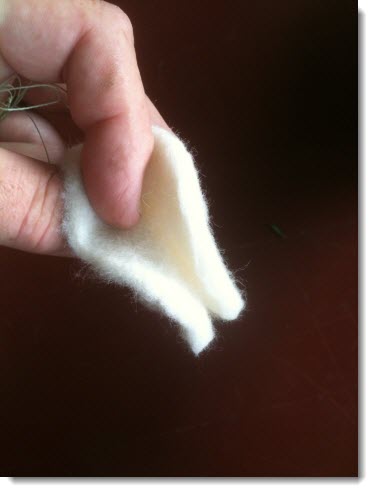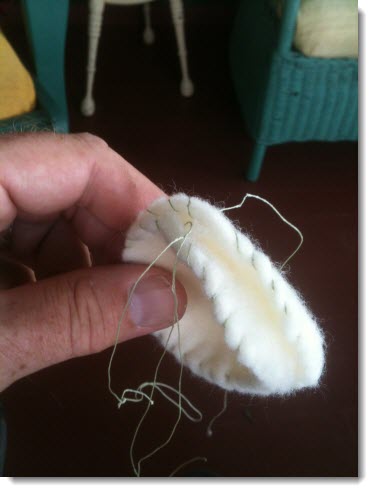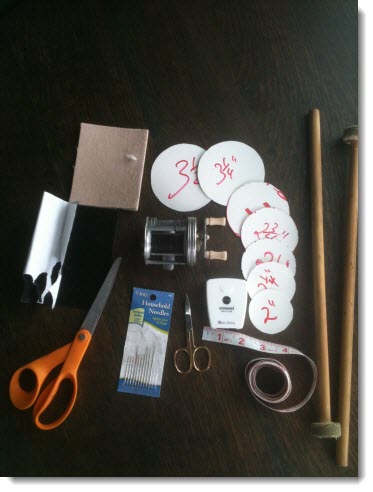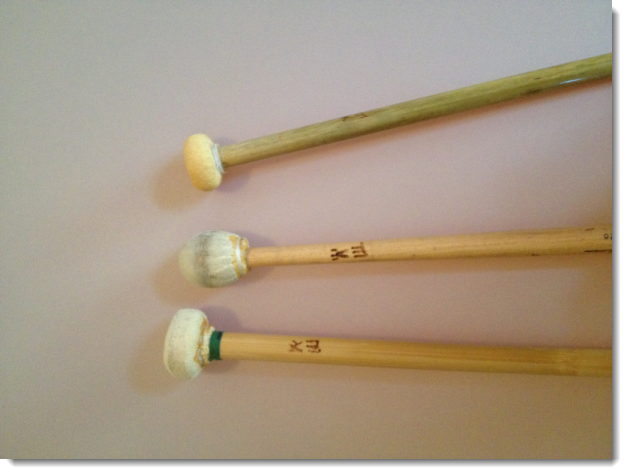With a little practice and patience you will be able to wrap your timpani mallets with ease. Just remember to take your time and everything will work out just fine.
My suggestion is to start by re wrapping some worn out mallets that you might have first and then graduate to building your own pair of mallets from scratch.
The Cartwheel is probably a little easier for most people to do so I’ll start with this type of wrap. However, ball type of timpani mallets are good because they won’t have a seam that you need to avoid when playing. And in general terms you can use a softer felt that will create a warmer tone on your drums.
Before you start wrapping your timpani mallets, let’s make a list of things you’ll need.
- Felt. You can use American Felt or Germanic Felt available from www.steveweissmusic.com. My felt is ¾” thick and I’m going to split it in half making sure that I have one piece that is big enough to cut two equal 3” circles from
- Unwaxed Dental floss, Braided Fishing line, or Dacron kite string. I’ve used Braided 30 lb test fishing line and un waxed dental floss and waxed dental floss. My preference is the fishing line because it won’t break. Some people use Dacron kite string, but I’ve yet to try it.
- Cuticle scissors. They are rounded and can help shape your mallet.
- A voicing tool is a great thing to have. You can buy one at www.steveweissmusic.com or make one with a piece of cork and three or four needles or pins.
- Sharp scissors
- Tape measure. Use a cloth of other type of flexible measuring tape like what a tailor would use
- Needles. You’ll have to learn how to sew if you don’t know already and when you buy needles to use make sure that the eye is not too small. Otherwise you’ll have a hard time to thread it.
- Pre-measured circles cut out of heavy paper or card board. 2”, 2 ¼”, 2 ½”,2 ¾ “, 3”, 3 ¼”, 3 ½”
- Glue. If you’re making very hard mallets with a very thin wrap you will have to glue the felt to the core. I use wood glue for this.
- You might need some Mole Skin or Craft Felt depending on whether or not you want to make your mallets softer
- Patience
I’m wrapping a pair of mallets that I’ve made with 15” bamboo shafts with cork disk mallet heads that measure 1 ¼” by ½”. I’ve shaped the cork so that the edges are rounded. If you’re making mallets from scratch you can use bamboo shafts or wooden dowel shafts. Wood dowels are easy to find at any hardware store and are great for a heavy mallet. Bamboo is a little harder find but there are places that will sell you shafts on line that are just right. A great place to buy bamboo timpani shafts is from Charles Cai of Bamboo Products of China. You have to buy a minimum of 100 pieces, but they are very nice. Charles can be reached at bamboocaicn@hotmail.com
You can buy bamboo shafts directly from us by visiting the Shop. The shafts that I have available are of the finest quality sanded bamboo which is sanded and sold in matched pairs according to weight and pitch.
You’ll need mallet cores and things like wooden wagon wheels from craft stores, layers of tape, cork (either from Champagne bottles or from www.corkstore.com).
Learn How to Wrap a Cartwheel Timpani Mallet in 11 Steps
The general description of a Cartwheel wrap is that a strip of felt is cut to measure so that it can wrap around the equatorial diameter of the mallet and sewn around the top and the bottom to make a tight fit. This type of wrap is good because it doesn’t use as much felt as the ball type of wrap and it is also a good wrap when you want to use a stiffer variety of felt, but I’ll discuss the felt type later on.
How to Wrap a Cartwheel Timpani Mallet Part 1
How to Wrap a Cartwheel Timpani Mallet Part 2
Step 1
Measure around the mallet head at its equator using a tape measure. My mallet is 3 1/2” around
Step 2
Measure the mallet head from the shaft to where the shaft either comes out of the top or where it might if the mallet head is closed and you can’t see. My mallet is 1 1/8 “
Step 3
Since you want two identical mallets you need to cut one piece that is twice the equatorial length and then cut that in half so that your felt for both mallets is the same thickness. Most felt comes in a thickness of ½”. I’m going to split the felt I need in half making sure that I have enough length in one piece for two mallets. So for my mallets I’m going to cut a piece of American Felt that’s 7” long and 1 1/8” wide and that has been split to a thickness of ¼”. Then I’ll cut the 7” strip into two equal lengths of 3 ½”
Step 4
There will be a fluffy side and a smooth side to the felt. You can make mallets with either side of the felt facing outward, but for this mallet I want the fluffy side out so I will have a warmer sounding mallet than if I had the smooth side out. Therefore I’m going fold the felt strip in half so the fluffy side is on the inside of the fold.
Step 5
Now for the first bit of sewing. Dental floss works well but there other choices for what you may want to sew your mallets with. A lot of people us Spider Wire fishing line and others use Dacron kite string. I’m going to use a double strand of un waxed dental floss this time. With whatever you chose to sew with you will sew a fairly tight stitch along the edges of the fluffy side. Make sure to lock your stitch at the beginning with a knot and at the end with a knot.
Step 6
Once you have sewn the seam, turn the felt inside out so now the fluffy side will be on the outside of the circular band of felt that you’ve just sewn together.
Step 7
If you’ve measured correctly this band of felt will fit snuggly over your mallet head which you will want to center over the mallet head.
Step 8
Sew the bottom along the shaft by loop stitching around the inside edge of the felt. Once you’ve gone all the way around pull your floss tight and tie it well.
Step 9
Sew the top of the mallet felt by loop stitching around the inside of the felt at the top. Once you have gone all the way around you should be able to pull the felt in tightly so that there will be only a little space or hole at the top of your mallet. Tie it tightly and you’re almost done.
Step 10
Hiding the extra floss after tightening your knots is easy. Put the loose threads into your needle eye and push the needle into the felt at under the floss stitch and pull the floss out through a thick part of the felt. Pull tight and cut closely so that the end disappears into the mallet. This will make a nice looking finished mallet.
Step 11
There will be a seam in this Cartwheel mallet you’ve made so fluff out the felt with a needle or a piano tuner’s voicing tool and mark the seam with a Sharpie pen or pencil.
I’m using American Felt purchased at www.steveweissmusic.com
Learn How to Wrap a Timpani Ball Mallet with a Butterfly Mallet Wrap in 12 Steps
How to Wrap Ball Style Timpani Mallets Part 1
How to Wrap Ball Style Timpani Mallets Part 2
Step 1
Measure your mallet head by placing your tape measure at the bottom of the ball where the shaft enters and measure over the top to the other side to where the shaft enters. Since German Style felt stretches subtract about ½” from your measurement. So, if you measure 3” use 2 ½” for your measurement.
Step 2
Using the appropriate sized cardboard circle that you have cut out trace the circle pattern on the felt and using the cuticle scissors cut out the circles of felt
Step 3
Split the felt. Most German style felt comes in a thickness of ¾ “ and you can split it in half or any other way. You might want to have thicker or thinner felt cover but normally half the standard felt is what you will use.

Step 4
To make a nice clean and tightly wrapped mallet I suggest that you do a Butterfly style wrap. After you’ve cut out your circle of felt split the circle of felt half way through all of the way around the circumference. You will now have two circles of felt that are joined together at the center by about one inch of felt.

Step 5
Sewing is tricky so take your time. Sew around the circumferences of each circle of felt using two separate lines. Don’t make your stitches too big. A good rule of thumb is to have your stitch as long at the felt is thick.
Step 6
Stitch all the way around the circumference of the felt circle and end your stitching to the point where you started from.

Step 7
You will have two circles of felt joined at the center and each will be stitched all the way around. Start with the inner circle of felt and pull the stitch tight making what might look like a bag of felt.
Step 8
Fit the bag over the mallet head and pull tightly. Ideally and if you’ve measured well the bag will very tightly over the mallet head to you should have to pull and stretch the felt until you can pull your threading material in tight to the shaft of the mallet.
Step 9
Once the inner circle is shaped and tight around the mallet head it’s time to tie it. If you can find a lovely assistant to hold the knot while you tie it that works well or you can tie a loop in one end of your tying thread, line or floss and loop it over something stationary like a snare drum stand, door knob, table leg, etc.
Step 10
Now pull the outer circle of felt tight around the mallet head in the same manner as the first. You’ll have to pull the fishing line and also stretch the felt with your hand to make a tight fit and then once again put the loop of the fishing line around the snare drum stand and pull it tighter and make your knot.
Step 11
After you’ve tied the knot thread the ends into the needle and push the needle back under the stitching. Pull the loose ends through the thickest part of the felt then pull tightly and cut the string. The loose ends will disappear back into the felt making a finished mallet with now loose threads showing.
Step 12
For a nicely finished look, use voicing tool to shape the felt and trim any loose felt with cuticle scissors. If you don’t have a voicing tool one can be made easily by putting 3 or 4 needles through a piece of cork.
How to Wrap Timpani Mallets with Chamois
Chamois covered timpani mallets are very popular these days especially for playing early Classical or Baroque timpani parts. The chamois covering provides a very articulate sound like wood sticks, but they are less “Pingy” in their sound quality. I use my chamois mallets for the music of Handel, Bach and sometimes, depending on the acoustics and nature of the ensemble with which I am playing I’ll use my chamois mallets for Mozart, Beethoven and Schumann to name a few of the composers that wrote timpani parts that demand a lot of articulation.
Take a look at this video to watch as I wrap a pair of chamois timpani mallets
Wrapping chamois mallets is relatively easy and quite a bit easier than wrapping your timpani mallets with felt. The reason for this is that you don’t have to do any sewing; you just tie around the base of the chamois, trim and seal it.
What you will need to wrap timpani mallets with chamois
Go to the hardware store or the auto supply store and buy some chamois in the car washing section of the store. You also need something to tie the chamois around your mallet like braided kite string, dental floss or braided fishing line. I like the kit string, myself.
You can put a chamois wrap around anything that you want. I’ve covered wooden and cork cores and in this video I wrap two layers of chamois over a 1” wooden wagon wheel that I previously covered with a very thin layer of American felt. You can also use Mole skin as an inside layer or craft felt with an adhesive backing.
There is a smooth side and a rough side to the chamois. When you wrap your mallets just be sure that you have the same side on the outside so that your mallets will match each other.
The first thing to do is to soak the chamois so it will be a little stretchy. This will allow you to pull out any creases in the covering so you’ll end up with a smooth playing surface. Once you’ve wrapped your mallets and the chamois dries there shouldn’t be any unwanted creases or folds.
Fold the chamois to double the thickness and place it over the mallet head, pulling tightly to smooth out the material. Then take your string and wrap 3 or 4 turns around the base of the mallet head and pull as tightly as you can. I use a Clove Hitch knot to finish and then I tie another knot with the loose ends that remain.
Once you have everything tied take a razor knife and carefully trim away the excess chamois by running your knife along the edge of your string. Make sure to use a very sharp knife for this.
To finish everything you will need some Krazy Glue, Super Glue or clear nail polish. Simply paint a coat of glue around the string to keep everything tightly sealed and to avoid thing coming undone. I made a pair of chamois mallets over 10 years ago and they’ve never come undone.
Chamois covered mallets from Top to Bottom
Two layers of chamois wrapped over a 1 inch wooden toy wagon wheel with an inside wrap of very thin American felt on a bamboo shaft
Two layers of chamois wrapped over a Saul Goodman #4 wood mallet
Two layers of chamois over a 1 ¼ X ½ inch cork disk on a bamboo shaft.



This is a great resource also for students who usually don’t have so much money to buy all the timpani sticks they need. Thanks!
hello, I do not really see the type of felt, can you give me the exact name of the product you use or reference, thank you
drummerval@gmail.com
The felt is commonly known as German felt for the ball sticks and I’m using America felt for he cartwheel sticks. You can order the felt by the sheet from Steve Weiss Music or California Percussion or Percussion Source.
Hope this helps
Thanks, Andrew! This is a great help!!
Do you have bamboo shafts you would be willing to sell, or know where I can find bamboo in smaller quantities than 100?
I’m glad this lesson was helpful. I do not have bamboo to sell at this time but here are a couple of ideas. The last time I bought some I split the 100 piece order with a friend because I didn’t want all 100 myself. I’ve seen bamboo on EBay for lots of 50 for what seemed to be a reasonable price. I think splitting an order among friends is the way to go.
Theresa,
I just stumbled on this http://www.professionalpercussionproducts.com/amystubbs.html. Its the web site for Professional Percussion Products and you can purchase all the materials for timpani stick building including bamboo shafts, felt, cores, etc…
If you are still looking for bamboo I now have some for sale. Please click on the “shop” tab at the top of this page to see what I have available.
Thanks.
Hey Andrew,
This is of great use to me; I may refurbish many sets I’ve discarded.
I would enjoy to see more closeups of the actual stitching. In the first video I can’t see what you’re doing exactly.
Thanks!
Thanks and I’m glad this is helpful. There are a couple of still photos in the directions on http://www.freepercussionlessons.com that should help show the stitching detail.
Don’t be afraid to fail a time or two as you learn. That’s what I did.
I actually managed to re-felt a set, having failed 2 previous times. The results are mediocre, but I’m sure I’ll improve, so I’m very happy I had some success. 1 stick is great, as the felt was almost too tight. The second has too much room; there’s either space between the felt and the cork or/and there’s folding of the felt creating an uneven surface.
Question: like the original felt, I’m using 6mm (half of the 12mm sheet) for a set. I suspect this to be to thin to perform a butterfly wrap (so 3mm). Would you agree or should I go ahead?
Also, I came across an experienced ‘refurbisher’ who varies the ‘tension’ of the felt itself: he pulls it very tight over the cores for a more staccato quality. An expensive set I own looks like this has been done too. Do you also practice this and what is your opinion about it.
Again, thanks for your help. Your website has been incredibly helpful to me.
Thanks for your question. I have failed at many mallets so it is just a matter of practice like anything else to develop the right techniques.
I usually try to wrap as tightly as possible and then I use a voicing tool or pin to fluff out the felt to make for a less staccato sound. The thickness of the felt has a lot to do with the hardness or softness of course. If you wrap with 3mm you may find that you might like the sound but you’d have the option of covering that again so you’d have two layers. Nothing wrong with that. My favorite pairs are made with a hockey tape core of 1″x 1/4 ” wrapped with a layer of Mole Skin, then American Felt, then Billiard Felt with a final ball wrap of German felt. Each wrap is very tight and the resulting mallet has some excellent articulation, but can also be used for most rolling passages, too.
If you are getting one mallet that is tight and the other is loose you may have some measurement issues, so measure twice and cut once. Make sure that you make two mallets from the same side of the piece of felt so the thickness is the same.
I’m glad you enjoy my web site and best of luck!
Hi Andrew,
Me again. I’m happy to say I’ve become quite able at doing this. I failed many times, but they started to look and sound better with every set. It freed up a whole world for me as I now don’t have to ‘spare’ my mallets anymore: I can get used to them, develop a better sound and ‘mallet pallet’ 😉 of different sticks of great quality!
This has made playing a great deal more fun to me.
But now I wonder how you would repair (orchestral) bass drum mallets. Do you use this same felt for it? Some heads seem to be wool or some other fabric. I’m hoping to repair my orchestra’s set so that we don’t have to buy new ones. As far as I can tell, roughly the same technique of refurbishing would apply to BD mallets, right?
Hope you can post something about that.
Thanks!
Yes. Wrapping bass drum beaters is just about the same as timpani mallets. Use German or American felt and use a cartwheel wrap. Depending on the shape of the mallet core you may have to trim and shape your wrap to fit.
Hello,
Thank you for this wonderful resource! Regarding chamois wrapping, if I can’t get a Soul Goodman wood mallet to wrap, could I wrap a Vic Firth wooden mallet with chamois? I’m just worried that the head would be too big, and the authentic sound would be affected. Thanks for your help!
Thanks for your question. Of course, you can wrap anything with chamois, but you’re right the Vic Firth Wood Mallet might be too large if you’re going for a “Period” sound. The Goodman mallets are readily available http://www.steveweissmusic.com/product/regal-tip-saul-goodman-wood-ball-timpani-mallets/timpani-mallets and you can also make mallets that will work well.
I have some bamboo shafts onto which I put on a cork disk that measures 1 1/4 by 1/2 inch. I cover that cork with chamois and it sounds and feels wonderful. You can also put a wooden wagon wheel onto any shaft (dowel or bamboo) and cover that with chamois which will sound very good, too.
If you’re interested I can make you a nice pair like I have with the cork on bamboo for $40 plus shipping. Just let me know.
Glad to help.
Thanks for the suggestions. For the moleskin, is it the kind for blisters and first aid usually sold at CVS or Walmart? Do you wrap it around the wood head and then stretch the chamois over? Thanks!
Also, do you know the head diameter/size of the Saul Goodman? Would like to get an idea of how big the mallet head would be. Thanks again!
The Goodman wood sticks are egg shaped and 1 inch across the diameter. With two layers of chamois the diameter is about 1 1/8 inch.
Yes. You can find Dr Scholl’s Mole skin at many drug stores. It’s sold in a couple of thicknesses so for this purpose I use the thinnest.
I demonstrate how I wrap with chamois in this video https://freepercussionlessons.com/how-to-wrap-timpani-mallets/
Would the difference between 1 vs 2 layers make a big difference in articulation? Just curious as to why you wrapped the mallets with 2 layers of chamois instead of one. I just don’t want my chamois mallets to sound like a very articulate felt mallet. Thanks.
Would the difference between 1 vs 2 layers make a big difference in articulation? Just curious as to why you wrapped the mallets with 2 layers of chamois instead of one. I just don’t want my chamois mallets to sound like a very articulate felt mallet. Thanks.
You’ll probably have to do your own experiments to see what you like best. I like the two layers because I felt 2 layers eliminated more of the tick and ping sound of wood against Mylar that I detest. I find that the two layers produce an articulate sound that is just about as articulate as bare wood but the tick or ping is not present. I’ve made single layer chamois over a thin Mole skin layer and I like that also. Have fun building your sticks and please let me know what you come up with that you like.